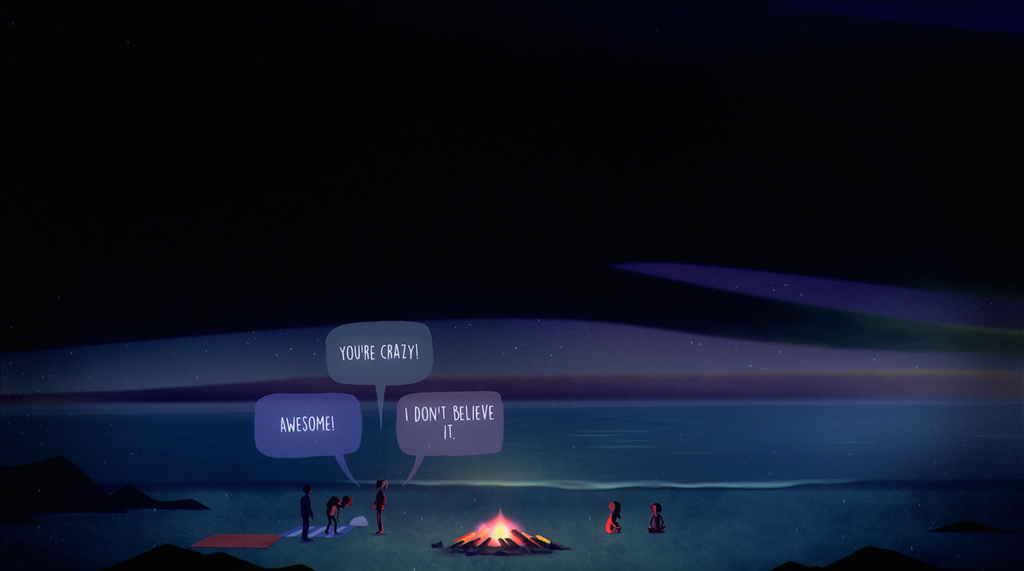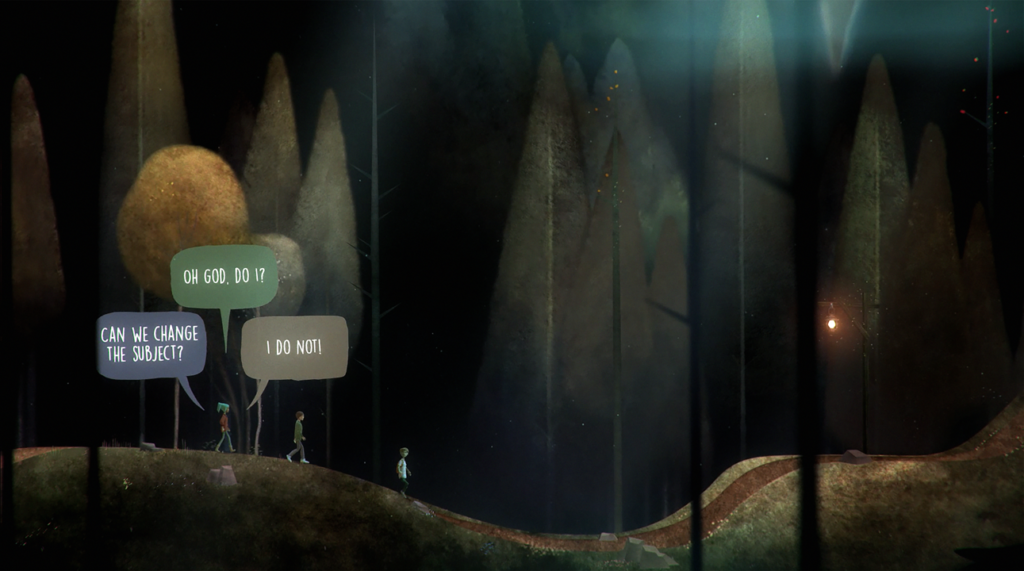Welcome back to Teacups & 1UPs, a column in which I lovingly pick apart games and pair them with tea. I hope you’re ready for some more Opinions About Games, because I’ve sure got some, and this time I’m talking Oxenfree.
“But Saf,” you groan, “are you ever not talking about Oxenfree?”
Probably not, but now I have a whole however-many-word-I-want to talk about it even more. Buckle up, kids, we’re going ghost hunting. Warnings for very light potential spoilers.
So, what is Oxenfree? It’s a story-driven, supernatural adventure game about a bunch of teenagers who sneak out to an island and unwittingly open a rift, setting vengeful spirits free. It’s also a game that approximately a million people told me I needed to play. They were right.
What struck me from the beginning was the voice acting. The first thing heard when the game begins is Ren, the classic never-shuts-up kinda guy who’s also the protagonist’s best friend, sounding almost like a radio host as he blabbers about the island you’re heading to. Each character’s voice distinctly captures their personality, and when put together they build a diverse ensemble before the game truly starts. When the visual representations of the characters are so small and largely without facial expression, their individual voices have to work double-time to express what might otherwise be missed. Plus, in a game that’s driven by dialogue, it’s important to have characters that don’t get boring to listen to. In my opinion, Oxenfree succeeds at these things with flying colours.
Of course, voice acting can’t save bad writing, so it’s a good thing that Oxenfree‘s writing is very good. Setting a game in an isolated environment with a small-ish cast is the perfect opportunity for strong storytelling and characterization to thrive—everything must be condensed down to really drive the narrative forward and make the player care about the characters. I’m personally a huge fan of shorter games with a big focus on story, and Oxenfree is exactly that. I love the dialogue, which is at times laugh-out-loud funny, and other times genuinely emotional. It’s easy to fall for one character and hate another, and then later have those feelings flipped.
During the night Oxenfree is set, the characters and writing develop subtly from the choices Alex—the player character—makes. Relationships can shift believably, and how Alex feels about any given subject is generally up to the player. Want her to be the silent, stoic type? Go for it. Want to make everyone hate her? Absolutely—there’s even an achievement for it. Unlike some other games, Oxenfree tends not to disguise the same choice as three different ones, and choices that a player might feel are fake absolutely do what the game says they will, which can be surprising and terrifying. At times, Alex is corralled into what the narrative needs, but even as that happens it still feels like your choice. There are also multiple endings, which are very much affected by various choices made throughout the game. I actually got what many call the “best” ending the first time around—but I’m not sure I’d consider it that.
Though Oxenfree isn’t a straight-up horror game, it’s definitely got a lot of creepy, tense moments and a heap of mystery. In fact, it is the mystery of what’s happening that really aids the mounting terror of exploring the island. Fear works best when the source is unknown, and there’s a lot of unknowns to be uncovered as the night goes on. It’s somewhat similar to Stranger Things in tone, and if you’re a fan of the show then Oxenfree is likely a game you’ll enjoy, too.
Oxenfree is also a coming-of-age story, exploring the point of time in a young adulthood where one is leaving what they know and moving into their next stage of life. There just also happen to be ghosts, too.
Though Alex’s personality is strong, in large part thanks to her VA, Erin Yvette, it’s also very open for the player to sculpt as they decide how Alex will cope with loss, new relationships, and how much she will insert herself into her own friends’ futures. These are common themes in YA fiction—and I feel Oxenfree definitely leans heavily in a YA direction—though the interactivity changes how the player might connect with them. You’re not a passive viewer of Alex’s story: you experience the consequences of how your different choices affect Alex and the other teens on the island.
The other characters will react to and remember choices the player makes, but it’s not only Alex’s actions that will be remembered. During the game, you’ll notice that thought bubbles will appear over a character’s head with another character’s face inside, which means that their opinion on that character has been affected in some way. This makes the NPCs feel as if they have some agency over themselves and their feelings, and lends a bit of realism to their relationships. Just as in real life, people’s relationships don’t only revolve around you, though you can nudge your friends in certain directions. It’s a nice touch, and a different take on games like The Walking Dead, with its ominous “Clementine will remember this” pop-ups.
Any game with branching dialogue needs a solid dialogue system, and Oxenfree has something that, again, differs a little from what other games may do. While conversations happen, speech bubbles pop up over Alex’s head giving three different options that lead to different responses. In an effort to continue the feeling of real people having real conversations, the dialogue options will fade and eventually disappear if nothing is chosen—except in circumstances where Alex needs to reply. It’s actually similar to how Firewatch‘s system works, so I guess I could say I’m pretty fond of this particular style.
What can be frustrating about this system is that it can often feel as if Alex is cutting someone else off to talk, as the options will disappear before the other character will finish their sentence and the game won’t always wait before Alex replies. On one hand, yeah, that can be how real life goes: speak before you forget what you want to say. On the other hand, sometimes you really just want to act with some goddamn courtesy.
That’s a seriously minor issue though, and on the whole I really dig how Oxenfree‘s dialogue system works, as well as the rest of the game’s writing in general. It’s a real delight to play, and the tension and mysteries are engrossing enough that I wanted to do all the extra side-things—which isn’t something I can say about a lot of games. The sound design is on point, mixing the horror of listening to half-tuned radio stations at midnight with a beautiful synth soundtrack; the art design is absolutely gorgeous and perfectly disconcerting at times; and the radio tuning mechanic? So good. Every aspect of Oxenfree works in tandem to deliver a solid supernatural story, with a really smart way of doing a new game+.
I’m not going to talk about the ending, because big spoilers, but I’m personally a huge fan of how it works in the context of a game. I’ve seen others less enthused about the ending, so YMMV. Regardless, Oxenfree is well worth a single play, and even a few more beyond that. There are even rumours of another secret ending that apparently almost nobody has found yet, though as more time goes on I’m beginning to doubt it’s existence. Even if it doesn’t exist (and I’m going to keep trying to find it until proven otherwise because it’s driving me crazy), there are still a bunch of other secrets to be found within the game. Time to bust out that old Morse code dictionary. (If that’s actually a thing.)
To pair: Earl grey with lavender. A dark tea perfect for an all-nighter solving mysteries, with a little extra twist of something to calm your nerves.





